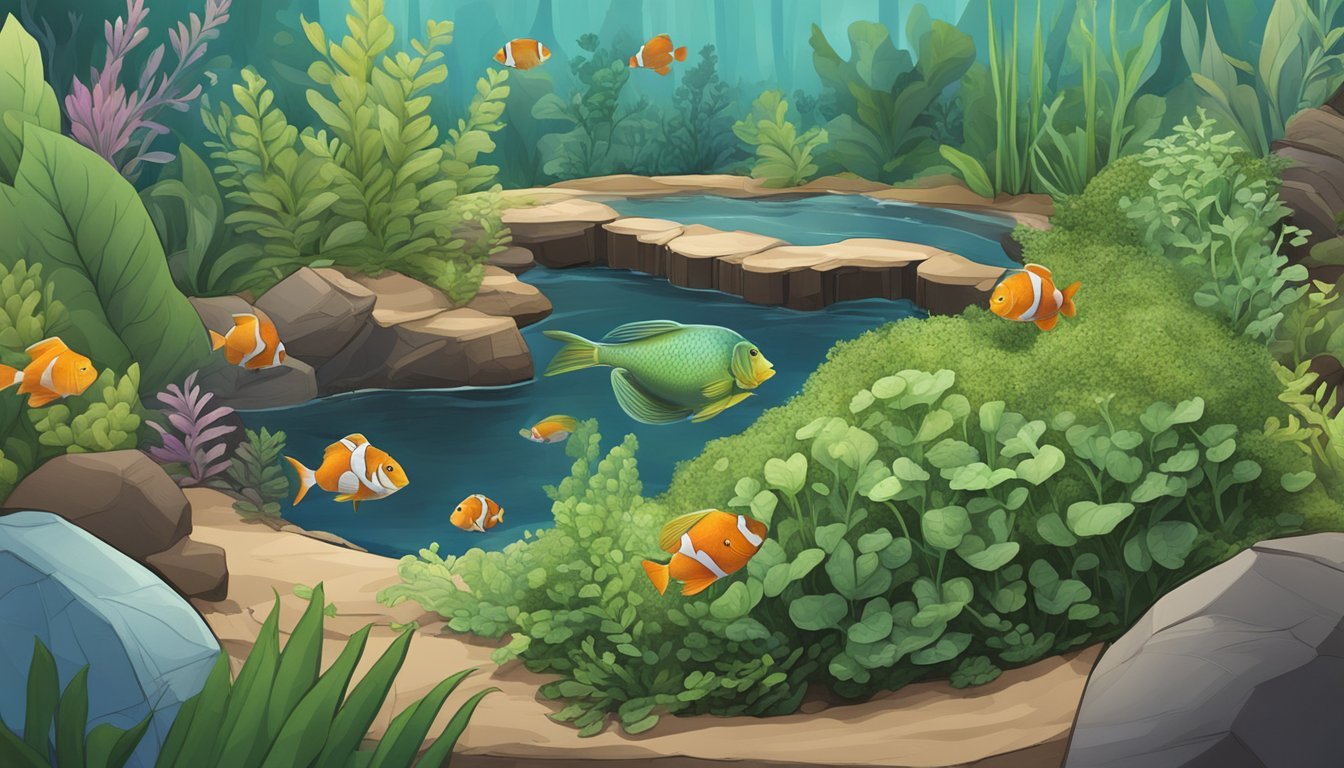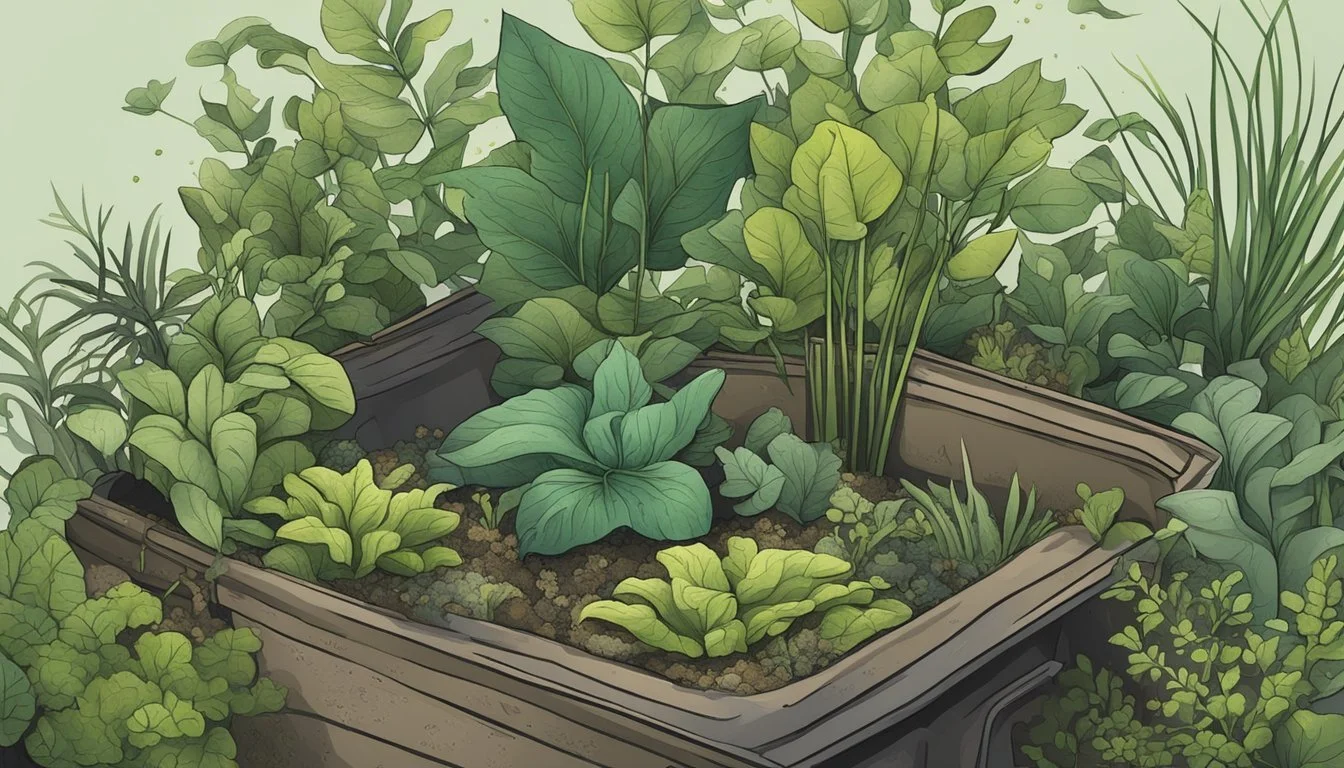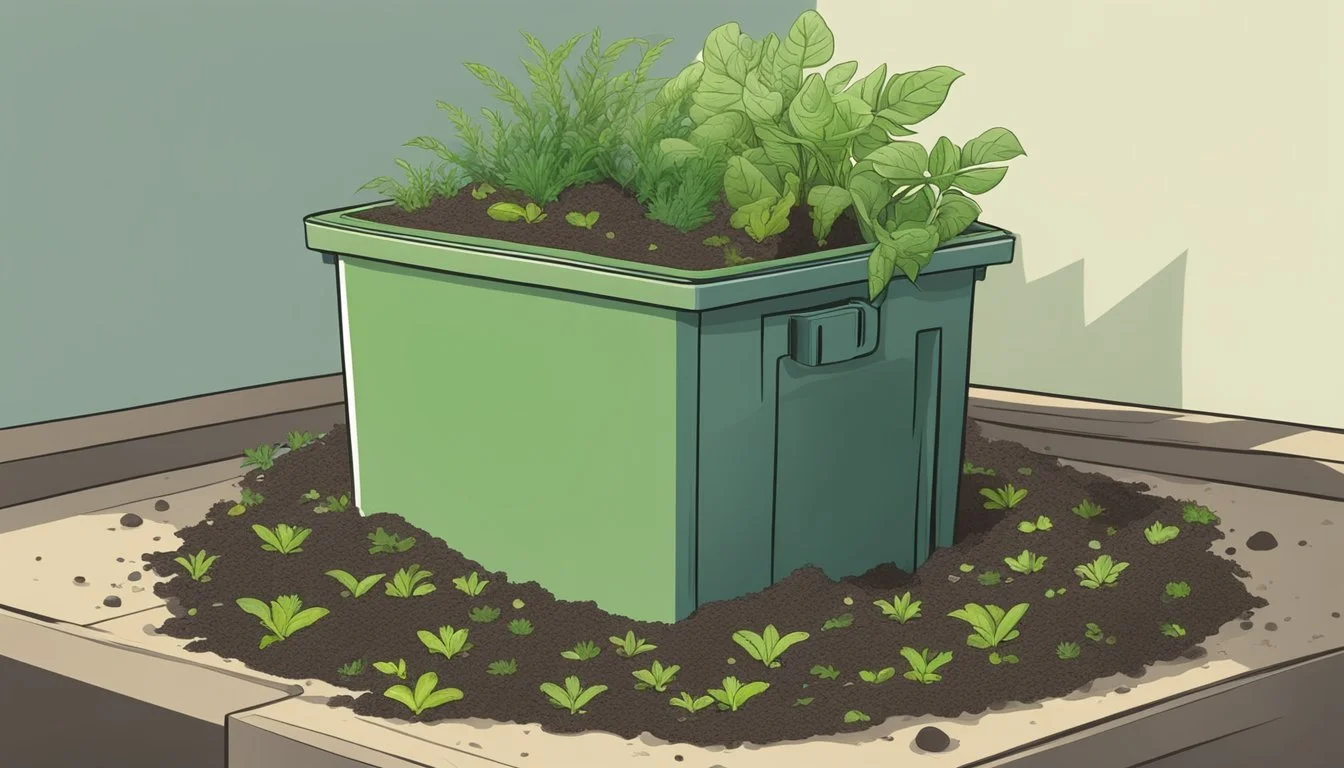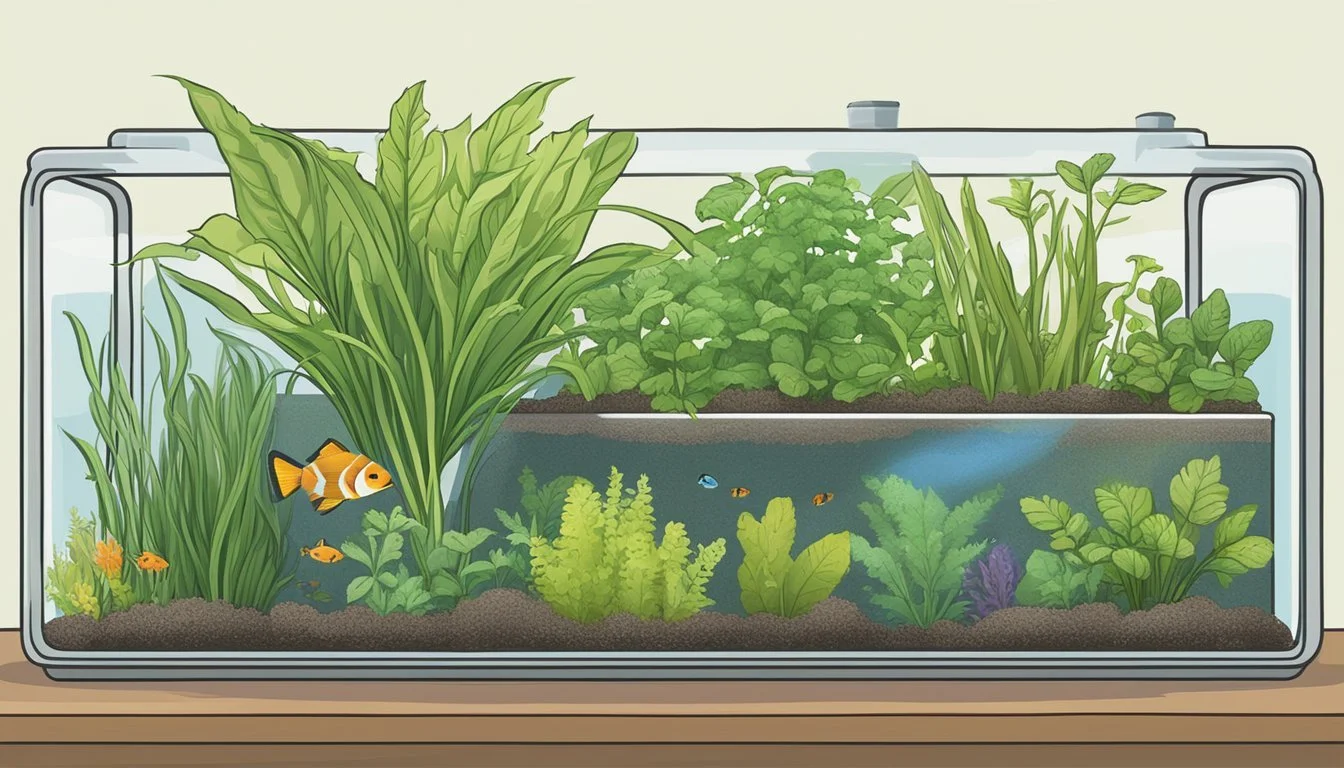Can You Compost Aquarium Plants?
A Guide to Responsible Disposal
Aquarium plants are often a subject of interest when discussing composting due to their unique origin and characteristics. In the world of recycling organic waste, composting is a well-established method for converting plant material into a rich soil amendment, beneficial for various gardening purposes. It is typical for aquatic horticulture enthusiasts to question whether the byproducts of their aquatic gardens, specifically aquarium plants, can be integrated into a traditional composting system.
The answer lies in understanding the nature of these plants and the composting process itself. Aquarium plants, much like their terrestrial counterparts, are composed of organic matter that can break down over time. When removed from an aquarium, these plants can be added to a compost pile, where, under the right conditions, they contribute to creating nutrient-rich compost. The decomposing process involves microorganisms and requires a balance of carbon and nitrogen, moisture, and oxygen to transform the plant matter into humus.
However, caution should be taken as some treatments and conditions of aquarium water, such as high salt content or the presence of disease treatments, may render the plants unsuitable for composting. It's critical to ensure the aquarium plants have not been exposed to harmful chemicals that could potentially leach into the compost and, subsequently, the soil. Therefore, while it is possible to compost aquarium plants, the specifics of their previous environments should be carefully considered to avoid negative effects on the resulting compost and the health of the ecosystem it supports.
Composting Basics
In the context of gardening and plant care, composting stands as a vital process for recycling organic material into a rich soil amendment. This section will elucidate what compost is, its benefits, and the right materials to use.
What Is Compost?
Compost is the end product of decomposed organic matter, which becomes a nutrient-rich, soil-like material. It is created through the natural breakdown process facilitated by microorganisms, such as bacteria and fungi, under controlled conditions. The resultant compost can be added to soil as a natural fertilizer, providing plants with vital nutrients and improving soil structure.
Benefits of Composting
Composting offers multiple advantages for both the environment and garden health:
Nutrient-Rich Soil: Enhances poor or depleted soils by adding essential nutrients.
Soil Structure: Improves soil aeration and water retention capabilities.
Waste Reduction: Lowers the amount of organic waste sent to landfills.
Sustainability: Supports a natural cycle of nutrients, reducing the need for chemical fertilizers.
Composting Materials
The materials for composting can be categorized into 'greens' and 'browns':
Greens: Include items like kitchen scraps and aquarium plants, which provide nitrogen.
Browns: Comprise paper and dead leaves, which offer carbon.
A proper balance between greens and browns is crucial for effective composting. For gardeners, it's important to know that they should avoid using materials treated with pesticides, as these can be harmful when introduced to the compost. Garden soil can serve as an initial substrate when starting a compost bin, but one should be cautious of adding wet soil directly into compost, as it can lead to an imbalance in the moisture level.
Aquarium Plant Composting
In the specialized practice of aquarium plant composting, enthusiasts turn spent plants into beneficial substrate material. This section outlines the materials suitable for compost and the appropriate methods to convert aquarium plants into compost.
Aquarium Plants as Compost Material
Aquarium plants, once they've reached the end of their lifespan, can serve as a nutrient-rich compost material. Both terrestrial and aquatic plants contain valuable organic compounds that, when decomposed, provide nourishment for soil-dwelling organisms and plants. However, it is essential to ensure that these plants are free from diseases and have not been treated with harmful chemicals or fertilizers that could detriment the composting process or later plant growth.
Composting Methods for Aquarium Plants
When composting aquarium plants, one should consider two primary methods:
Traditional composting:
Collect the aquarium plants and mix them with existing compost.
Add brown materials (like dried leaves or twigs) to balance the green waste from the plants.
Regularly aerate and turn the pile to speed up decomposition.
Vermicomposting:
Introduce red wrigglers or other composting worms to the collected aquarium plant material in a worm bin.
These worms expedite the composting process by breaking down the plant matter rapidly.
Each of these methods will eventually transform discarded aquarium plant material into a fertile substrate that can be used to enhance soil quality for further gardening applications. It's crucial to avoid including any substrate material such as gravel or sand which will not decompose and could potentially impede the composting process.
Aquarium Maintenance & Plant Trimming
Regular maintenance of an aquarium includes trimming plants which is essential for fostering a thriving aquatic environment. It promotes healthy plant growth, deters algae, and ensures the well-being of the fish by preserving both the aesthetics and functionality of the ecosystem.
Trimming Aquarium Plants
Trimming aquarium plants is similar to pruning garden plants; it's necessary for controlling size and shape and encouraging new growth. Aquarists should:
Use scissors with an s-bend shape for precision.
Trim overgrown leaves and stems to allow light to reach the lower parts of the tank, which helps prevent algae overgrowth.
Remove dead or decaying plant matter to keep the water clean and maintain efficient filter functioning.
Cut plants horizontally, following the substrate's curvature, especially for carpeting plants.
Specific aquascaping techniques improve the aesthetic appearance of the aquarium and create an environment where fish can thrive.
Healthy Aquarium Ecosystem
A healthy aquarium ecosystem relies on the balance between plant life, fish, and the filtration system:
Plants utilize waste products from fish, reducing potential harm.
Fish benefit from the oxygen produced by plants through photosynthesis.
Filters are less burdened when excess plant matter is removed since there's less detritus to process.
Trimming plants not only boosts their health and growth but also contributes to the ecological equilibrium of the aquarium.
Aquarium Plant Properties
Aquarium plants bring vitality to aquascapes and provide essential nutrients that maintain ecological balance. They vary widely in type and nutrient content, emphasizing their role in a flourishing aquatic ecosystem.
Aquatic Plant Types
Java Fern (Microsorum pteropus) is a classic example of an aquatic plant commonly used in aquarium setups. It is robust, able to adapt to a wide range of conditions, and does not require substrate to thrive. Other popular types include:
Anubias: Slow-growing and suitable for shaded areas.
Cryptocoryne: Known for its varied textures and colors.
Echinodorus: Commonly referred to as sword plants, they have large leaves.
Mosses: Such as Java Moss, they provide shelter for fish and are easy to maintain.
Each species contributes uniquely to the aquarium's environment, from oxygenating the water to providing hiding spaces for fish and invertebrates.
Nutrients in Aquarium Plants
Aquarium plants require both macro and micronutrients for healthy growth. The macronutrients include nitrogen, phosphorus, and potassium (N-P-K), which are vital for development and energy transfer. Micronutrients are needed in smaller amounts and include iron, manganese, and zinc, among others.
Beneficial nutrients in aquarium plants:
Nitrogen: Crucial for protein formation.
Phosphorus: Aids in energy transfer.
Potassium: Regulates osmotic balance.
Micronutrients like iron are particularly important in sustaining vibrant foliage and overall health, preventing yellowing leaves which indicate deficiency. Java Fern, for instance, exhibits resilience partly because it can access micronutrients directly from the water column through its leaves.
Soil Composition
The composition of soil is crucial when considering composting aquarium plants. The right blend enhances plant growth and assists in the breakdown process within compost systems.
Suitable Soil for Compost
The most effective compost for aquarium plants is one that mimics their natural aquatic environment. This means a soil that is rich in organic matter and has a balanced mix of elements. Garden soil alone is often too dense and may not provide the necessary aeration and drainage. A suitable compost would ideally be a mix that includes:
Peat, which helps to keep the soil loose and absorbent,
Sand, to aid drainage and prevent compaction,
A smaller proportion of clay for nutrient retention, and
Topsoil or potting soil, which can be added to introduce a diverse range of microorganisms beneficial for plant growth.
Improving Garden Soil with Compost
Composting aquarium plants can be a natural way to improve garden soil. The key is in the balance:
1 part peat: Helps increase the porosity of the garden soil.
2 parts sand: Ensures that the soil remains well-drained and not waterlogged.
By including compost made from aquarium plants into garden soil, one can increase the organic content, which in turn:
Enhances the soil structure,
Encourages the presence of beneficial bacteria and fungi, and
Provides essential nutrients to the plants.
Potting mix can be incorporated into this blend for garden use, especially to lighten heavy soils. When treated correctly, compost that includes decomposed aquarium plants can become a rich, nourishing amendment that benefits both aquatic and terrestrial gardening scenarios.
Integration with the Garden
Aquarium plants can add value to a garden ecosystem when composted effectively. The nutrients they provide can enhance soil fertility and structure.
Incorporating Compost into Garden Beds
Compost from aquarium plants, when broken down, introduces beneficial bacteria and microorganisms into garden beds. Gardeners should mix this compost into the top layers of soil, ensuring that it's fully decomposed to avoid any potential harm to terrestrial plants. The integration of aquarium plant compost can also increase water retention, which is beneficial for garden health.
Recommended compost to soil ratio: approximately 1:3
Depth of integration: top 6-8 inches of the garden bed
Compost as Base Layer
In the construction of new garden beds, using compost from aquarium plants as a base layer underneath fresh garden soil can be advantageous. This layer acts as a slow-releasing fertilizer as it continues to break down, providing ongoing nutrients for the plants.
Constituents for an optimal base layer:
40-60% garden compost
20-30% peat or peat alternatives
10-20% mulch (wood chips or straw)
When using compost as a base layer, it is vital to ensure proper layering to prevent the mixing of components that might alter the intended benefits. Avoid adding too much compost to prevent over-fertilization, which can lead to excessive leaf growth at the expense of flowers and fruit.
Environmental Considerations
When composting aquarium plants, it's vital to address environmental factors such as the control of algae and weeds and preventing nutrient leaching, which can impact ponds and local waterways.
Controlling Algae and Weeds
Composting aquarium plants needs to be done with consideration for algae control. Algae thrive in nutrient-rich environments, and excess nutrients from decaying plant matter can exacerbate algae blooms. Properly composting aquarium plants helps reduce the likelihood of these outbreaks by minimizing the direct introduction of nutrients into the water.
Keep the compost pile balanced: A balanced compost pile with the right mix of green (nitrogen-rich) and brown (carbon-rich) materials will decompose appropriately without contributing to excessive nutrient levels.
Avoid adding invasive plants: Some aquarium plants are invasive in natural water bodies and could encourage weed growth if not disposed of correctly.
Preventing Nutrient Leaching
Nutrient leaching from compost into water bodies can disrupt the ecological balance. If nutrients such as nitrogen and phosphorus enter the pond or local water systems, they can lead to eutrophication, a process where water bodies receive excess nutrients, fostering the growth of algae and harming aquatic life.
Use a contained composting system: This helps ensure that leachate, the liquid that drains from the compost pile, does not contaminate water sources.
Monitor pH levels: The pH of the compost should be monitored to ascertain it remains neutral; extreme pH values can affect the solubility and hence the mobility of the nutrients.
DIY Composting Techniques
In adopting a sustainable approach to aquarium care, DIY composting techniques offer a resourceful way to recycle aquarium plants and organic waste. Utilizing simple methods, one can transform waste into beneficial compost for aquatic and terrestrial plants.
Home Composting Systems
Home composting systems are an excellent way to manage organic waste, including aquarium plants. One begins by setting up a composting bin or area, segregating compostable materials, and maintaining proper conditions for decomposition. Here's a basic guide:
Materials to Include:
Aquarium plants: They break down and enrich the compost.
Vegetable scraps: A great source of nitrogen.
Paper napkins: Carbon-rich material that absorbs excess moisture.
Materials to Exclude:
Algae: Can introduce unwanted elements to the compost.
Colored paper: May contain harmful dyes.
Maintenance:
The compost should be turned regularly to ensure aeration.
The moisture level needs to be balanced; not too wet, not too dry.
Aquatic Compost DIY
Creating aquatic compost specifically for pond plants can be achieved using heavy clay soil as a base due to its ability to hold water and nutrients effectively. When making aquatic compost, one needs to:
Select Soil:
Heavy Clay: Ideal for anchoring plants and retaining nutrients.
Enrich Soil:
Aquarium Plant Debris: Adds necessary organic matter.
Sifter Technique:
Use a sifter to remove debris and achieve a fine texture.
In summary, incorporating DIY composting techniques can significantly benefit both aquarium and garden environments. By understanding and applying the right methods for home and aquatic composting, individuals contribute to a greener ecosystem.
Potential Issues
When composting aquarium plants, one must consider the presence of fertilizers and chemicals, as well as the need to manage pH and nutrient levels. These factors play a significant role in determining the success of composting these plants while avoiding potential harm to the compost ecosystem.
Dealing with Fertilizers and Chemicals
Aquarium plants often come into contact with various fertilizers and chemicals designed to maintain a healthy aquatic environment. However, these substances can pose challenges when plants are transferred to compost. Fertilizers may contain high levels of nitrogen and phosphorous, which, if excessive, can disrupt the composting process or harm plant growth when the compost is later used in gardening. Additionally, chemical treatments such as algicides or antibacterial agents used in aquariums can affect the microorganisms essential for effective composting.
It is crucial to:
Rinse the aquarium plants thoroughly to remove any traces of chemicals.
Understand that aquarium-specific fertilizers may need time to break down or be diluted in the compost pile to prevent any negative impact.
Managing pH and Nutrient Levels
The overall health of compost depends heavily on maintaining the right balance of pH and nutrient levels. Aquarium plants can alter this balance due to the substrate they were grown in and the water conditions they adapted to. For instance, compost requires a neutral to slightly acidic pH, but aquarium water often contains buffers that could skew this balance.
Effective management involves:
Utilizing a gravel cap when initially laying down aquarium plants in compost to contain any residual nutrients and prevent them from excessively leaching into the compost.
Regularly testing the pH and adjusting the compost mixture with organic materials to moderate pH levels and background nutrient content, ensuring they fall within the ideal range for microbial activity and decomposition.
Adding Enrichment
Enrichment to compost from aquarium plants can be achieved by adding various organic materials that contribute nutrients and improve the composting process.
Using Herbs and Vegetable Scraps
One can enrich compost by adding herbs and vegetable scraps. These organic materials are rich in nutrients and decompose readily, providing a balanced mix of nitrogen, which is essential for composting. Ideal scraps include leaves from herbs such as parsley and cilantro, and remnants from vegetables like carrot tops and lettuce.
Herbs: Basil, cilantro, parsley (leaves and stems)
Vegetable Scraps: Carrot peelings, lettuce leaves, cucumber ends
Incorporating Paper and Natural Fibers
Composting can also benefit from the addition of paper napkins and natural fibers like hay and pine needles. These items introduce carbon into the compost, which interacts with the nitrogen from the herbs and vegetable scraps to facilitate the breakdown process.
Paper Napkins: Should be unbleached, free from ink or dyes
Natural Fibers:
Hay: Provides structure and aeration within the compost pile
Pine Needles: Decompose slowly; add sparingly to maintain balance







